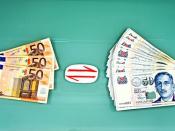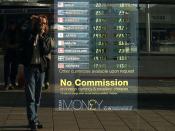In order for countries to trade they must be able to exchange currencies. The buying country must acquire the selling country?s currency in order to purchase goods. In order to determine at what rate one currency should be traded for another one must examine the notion of purchasing power. The idea that exchange rates should equal purchasing power is best illustrated by the following example. If a Big Mac costs three dollars in Canada the accurate exchange rate for the Chinese Yuan will be one that exchanges three Canadian dollars for the amount of Yuan it would take to purchase a Big Mac in China. If the Big Mac costs thirty Yuan then the exchange rate between the two countries should equal ten Yuan for one Canadian dollar. The Big Mac example is one that is used in an exchange rate theory called the ?Law of One Price?. This law states that: ?the relative prices of any single good between countries, expressed in each country?s currency, is representative of the proper or appropriate exchange rate value.
This would always be the case in a perfect system; however as is the case with many theoretical applications they are not always true in real life situations. Purchasing power does not always equal the real exchange rate. The Big Mac index compares these two factors, and one can find many discrepancies between actual rates and implied purchasing power. The Chinese economy is one of the fastest expanding economies in the world today. There is international pressure on China because many countries are finding it difficult to compete with China?s low prices, and thus demanded the revaluation of the Chinese Yuan. With the Yuan at its current level they cannot compete with China and their domestic industries will be hurt.


